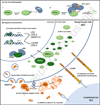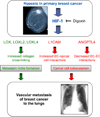Molecular mechanisms mediating metastasis of hypoxic breast cancer cells
- PMID: 22921864
- PMCID: PMC3449282
- DOI: 10.1016/j.molmed.2012.08.001
Molecular mechanisms mediating metastasis of hypoxic breast cancer cells
Abstract
Breast cancers contain regions of intratumoral hypoxia in which reduced O(2) availability activates the hypoxia-inducible factors HIF-1 and HIF-2, which increase the transcription of genes encoding proteins that are required for many important steps in cancer progression. Recently, HIFs have been shown to play critical roles in the metastasis of breast cancer to the lungs through the transcriptional activation of genes encoding angiopoietin-like 4 and L1 cell adhesion molecule, which promote the extravasation of circulating cancer cells from the lung vasculature, and the lysyl oxidase family members LOX, LOXL2, and LOXL4, which promote invasion and metastatic niche formation. Digoxin, a drug that inhibits HIF-1 activity, blocks primary tumor growth, vascularization, invasion, and metastasis in ex vivo and in vivo assays.
Copyright © 2012. Published by Elsevier Ltd.
Figures







Similar articles
-
Cancer-stromal cell interactions mediated by hypoxia-inducible factors promote angiogenesis, lymphangiogenesis, and metastasis.Oncogene. 2013 Aug 29;32(35):4057-63. doi: 10.1038/onc.2012.578. Epub 2012 Dec 10. Oncogene. 2013. PMID: 23222717 Free PMC article. Review.
-
Inhibitors of hypoxia-inducible factor 1 block breast cancer metastatic niche formation and lung metastasis.J Mol Med (Berl). 2012 Jul;90(7):803-15. doi: 10.1007/s00109-011-0855-y. Epub 2012 Jan 10. J Mol Med (Berl). 2012. PMID: 22231744 Free PMC article.
-
Hypoxia-inducible factor-dependent breast cancer-mesenchymal stem cell bidirectional signaling promotes metastasis.J Clin Invest. 2013 Jan;123(1):189-205. doi: 10.1172/JCI64993. Epub 2012 Dec 17. J Clin Invest. 2013. PMID: 23318994 Free PMC article.
-
ITGA6 is directly regulated by hypoxia-inducible factors and enriches for cancer stem cell activity and invasion in metastatic breast cancer models.Mol Cancer. 2016 Mar 22;15:26. doi: 10.1186/s12943-016-0510-x. Mol Cancer. 2016. PMID: 27001172 Free PMC article.
-
Hypoxic pathobiology of breast cancer metastasis.Biochim Biophys Acta Rev Cancer. 2017 Aug;1868(1):239-245. doi: 10.1016/j.bbcan.2017.05.004. Epub 2017 May 16. Biochim Biophys Acta Rev Cancer. 2017. PMID: 28526262 Review.
Cited by
-
Three-dimensional and co-culture models for preclinical evaluation of metal-based anticancer drugs.Invest New Drugs. 2015 Aug;33(4):835-47. doi: 10.1007/s10637-015-0260-4. Epub 2015 Jun 21. Invest New Drugs. 2015. PMID: 26091914
-
Concurrent targeting of eicosanoid receptor 1/eicosanoid receptor 4 receptors and COX-2 induces synergistic apoptosis in Kaposi's sarcoma-associated herpesvirus and Epstein-Barr virus associated non-Hodgkin lymphoma cell lines.Transl Res. 2013 Jun;161(6):447-68. doi: 10.1016/j.trsl.2013.02.008. Epub 2013 Mar 20. Transl Res. 2013. PMID: 23523954 Free PMC article.
-
Hypoxia and the extracellular matrix: drivers of tumour metastasis.Nat Rev Cancer. 2014 Jun;14(6):430-9. doi: 10.1038/nrc3726. Epub 2014 May 15. Nat Rev Cancer. 2014. PMID: 24827502 Free PMC article. Review.
-
New perspective into mesenchymal stem cells: Molecular mechanisms regulating osteosarcoma.J Bone Oncol. 2021 Jun 23;29:100372. doi: 10.1016/j.jbo.2021.100372. eCollection 2021 Aug. J Bone Oncol. 2021. PMID: 34258182 Free PMC article. Review.
-
PITX1, a specificity determinant in the HIF-1α-mediated transcriptional response to hypoxia.Cell Cycle. 2014;13(24):3878-91. doi: 10.4161/15384101.2014.972889. Cell Cycle. 2014. PMID: 25558831 Free PMC article.
References
-
- Vaupel P, et al. Tumor hypoxia and malignant progression. Methods Enzymol. 2004;381:335–354. - PubMed
-
- Vaupel P, et al. Detection and characterization of tumor hypoxia using pO2 histography. Antioxid. Redox Signal. 2007;9:1221–1235. - PubMed
-
- Vaupel P, et al. Prognostic potential of the pre-therapeutic tumor oxygenation status. Adv. Exp. Med. Biol. 2009;645:241–246. - PubMed
-
- Wilson WR, Hay MP. Targeting hypoxia in cancer therapy. Nat. Rev. Cancer. 2011;11:393–410. - PubMed
Publication types
MeSH terms
Substances
Grants and funding
LinkOut - more resources
Full Text Sources
Medical

